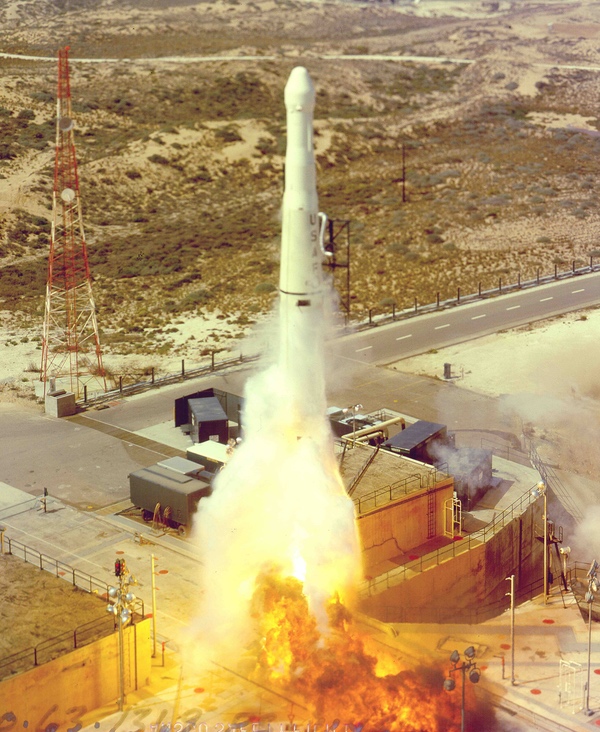Nuclear Transit: nuclear-powered navigation satellites in the early 1960sby Dwayne A. Day
|
| An APL engineer personally transported the power source to the Cape, putting it in the trunk of his car when he drove to the airport, and then carrying it in a borrowed Marine Corps attack jet down to the Cape, violating multiple regulations regarding the safe transport of nuclear materials. |
Before there was GPS there was Transit, a satellite system developed by the US Navy to enable ballistic missile submarines to determine their position at sea by poking a satellite antenna above the waves. Transit was developed during a true eureka moment at the beginning of the space age. Physicists at Johns Hopkins University’s Applied Physics Laboratory (APL) outside Washington, DC, had long used the Doppler shift of a signal transmission to track missiles launched from shore—not only did the signal change as the transmitter sped away from the receiver, it would also shift if the transmitting missile flew to the left or the right. When the Soviet Union launched Sputnik in 1957, two APL physicists worked to track it based upon the Doppler shift of its signal. One of their colleagues noted that whereas their method was based upon knowing the location of the receiver on the ground, the obverse would also be true—if you knew the trajectory of the satellite over the Earth, you could calculate your own position relative to the satellite. That technique could be used by ships at sea, particularly the new Polaris ballistic missile submarines that needed to know their position to fire their missiles at targets thousands of kilometers away.
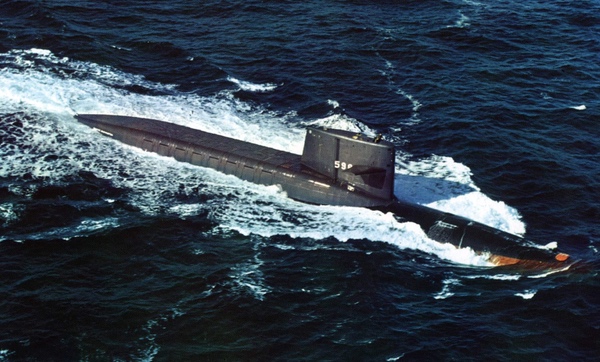 The USS George Washington was the United States’ first ballistic missile submarine, launched in 1959. The submarines relied upon inertial reference systems to determine their position, but these systems needed to be updated regularly. The Transit satellite was a method of providing new positioning data to subs and ships at sea, and became operational by 1964. (credit: Us Navy) |
Like many new projects in the early space age, designers moved fast. Development of the system began in 1958 and a prototype was launched by September 1959, but did not reach orbit. By April 1960, a second prototype was successfully launched and proved the concept was sound. The program, named Transit, became operational by 1964, and Polaris submarines used it to update their inertial navigation systems before diving to deeper waters. A single fix from a single satellite was not as good as two signals from different satellites, but submarine launched ballistic missiles were initially intended to destroy cities, not specific targets. A user that could wait for multiple satellite passes, like a surveyor in a remote location, could develop a very precise fix on their position using only a single satellite.
The first Transit satellites, launched in 1959 and 1960, were ball-shaped. By 1961, APL had changed to a cylindrical design, including Transit 4A and 4B, which contained a small nuclear power source to provide secondary power as an experiment. An APL engineer personally transported the power source to the Cape, putting it in the trunk of his car when he drove to the airport, and then carrying it in a borrowed Marine Corps attack jet down to the Cape, violating multiple regulations regarding the safe transport of nuclear materials.
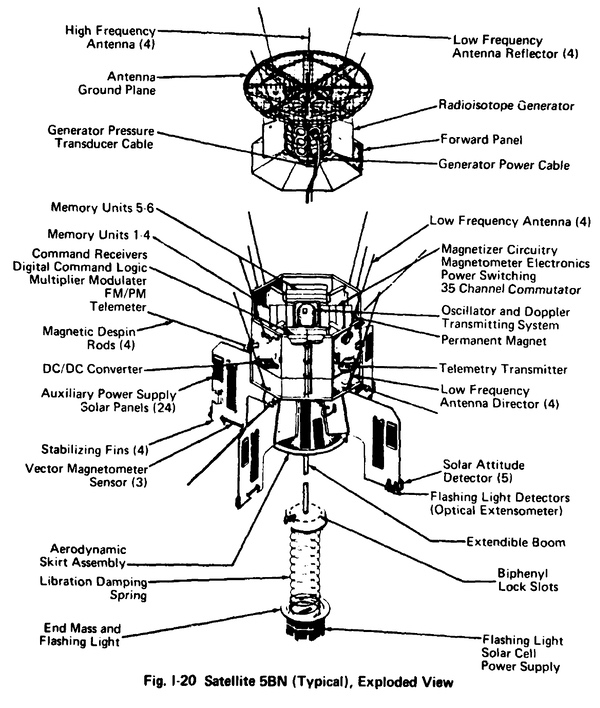 The Transit 5BN satellites used a gravity gradient boom to orient the satellites with their antennas pointed down toward Earth. Note the nuclear power source mounted behind the main antennas. The stabilizing fins on the satellite were intended to enable it to burn up in the upper atmosphere during reentry or an accident, in order to vaporize its one kilogram of plutonium-238. This happened during one launch failure, and resulted in a change in design philosophy for American nuclear powered spacecraft. (credit: APL) |
By 1963, the satellites became more complex in shape. After the successful tests involving 4A and 4B, by 1963 APL engineers wanted to investigate if the satellites could be primarily nuclear-powered, using a radioisotope thermoelectric generator, or RTG, which could last longer in space than existing solar panels. The reason was that the satellites had a five-year lifetime goal, and it was unclear if solar cells and batteries could achieve this. This led to the Transit 5BN series, “N” for “nuclear.” Until recently, no good photographs of the 5BN satellites have been published, but photos of a satellite during payload integration at the central California launch site have now emerged.
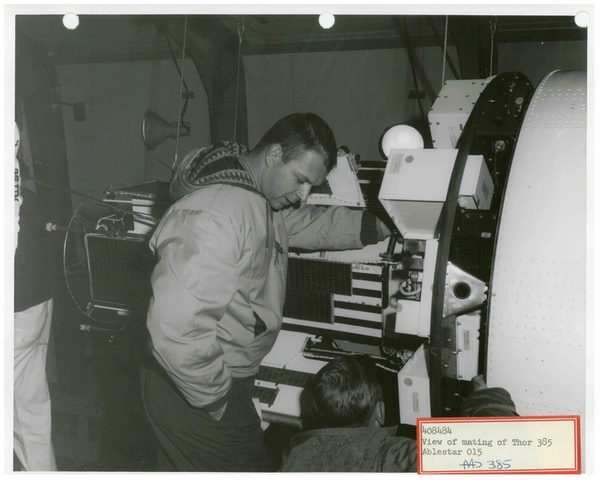 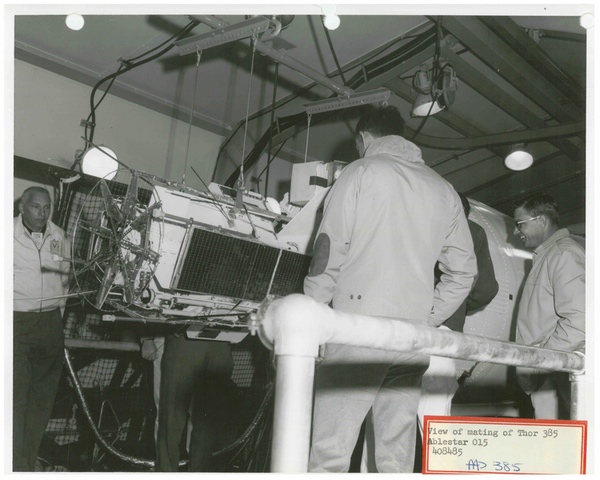 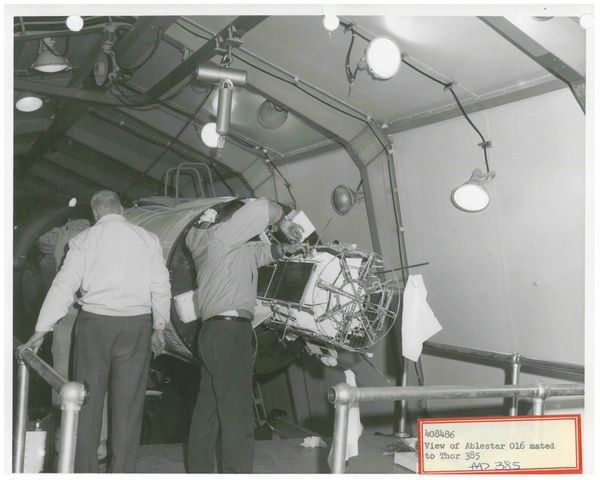 Payload integration of a Transit 5BN satellite to its Thor Able-Star rocket at Vandenberg Air Force Base. Despite the labels, these are probably all the December 1963 launch of the second Transit 5BN, which was successful. The nuclear power source was located behind the forward antenna. (credit: USAF) |
Transit 5BN Debuts
Three Transit 5BN satellites were launched from Vandenberg Air Force Base, on September 28 and December 6, 1963, and April 21, 1964, although the last mission failed to achieve orbit. They were lofted into space aboard Thor Able-Star rockets.
| By 1963 APL engineers wanted to investigate if the satellites could be primarily nuclear-powered, using a radioisotope thermoelectric generator, or RTG, which could last longer in space than existing solar panels. |
Thor started life as an intermediate range ballistic missile equipped with a nuclear warhead, in active service until the early 1960s. After being withdrawn from service, the missile was modified into a space launcher, launching from both Florida and California. For the first two decades of the space age, the Thor was the workhorse rocket for the United States military and NASA, eventually evolving into the Thor-Agena, Thor-Delta, Delta, and finally the Delta II, which proved to be just as consequential for NASA. Thor carried many military payloads into space, most famously more than 100 CORONA reconnaissance satellites into polar orbit. The Able-Star second stage used hypergolic propellants and a descendant of its engine continued in use until the last Delta II rocket launch in 2018.
The 5BN satellites were equipped with transmitters of 136, 150, and 400 megahertz. They were powered by a SNAP-9A radioisotope power source that was intended to provide a long lifetime. Solar cells and batteries powered the 136-megahertz auxiliary system. The satellites also had a gravity gradient stabilization system—pioneered by Transit 5A-3 in 1963—deploying a long boom that was intended to orient the satellite so that the transmitters aimed towards Earth.
The satellites were octagonal prisms 46 centimeters (18 inches) across by 30 centimeters (12 inches) high. The SNAP-9A section was a cylinder 30 cm in diameter by 20 cm (8 inches) high. The mass ranged from 69 kilograms (154 pounds) for 5BN-1 to 75 kilograms (167 pounds) for 5BN-3. The satellites were also designed with four fins located with respect to the center of mass. This was intended to ensure that the SNAP-9A power source burned up either during accidental reentry during launch failure or after the satellite’s orbit eventually decayed.
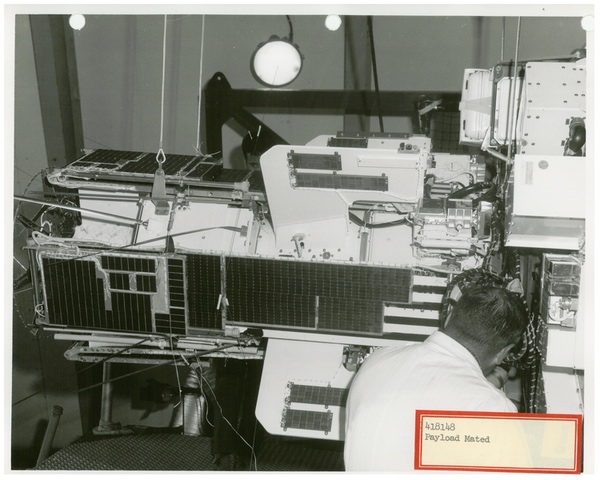 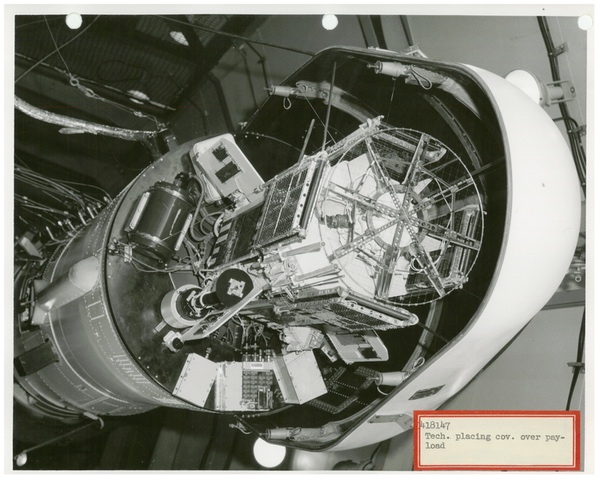 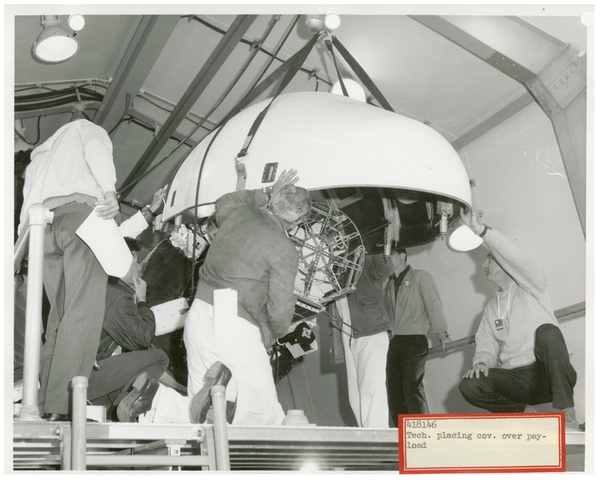 Final integration of the Transit 5BN satellite. The nuclear power source was intended to provide primary power to the satellite. The solar panels provided backup power to a transmitter that relayed satellite telemetry. The concept was to determine if nuclear power could enable long-lived satellites, with a design goal of five years. But the Navy and the Applied Physics Laboratory determined that solar power was sufficient, and subsequent Transit satellites were all solar-powered. The Transit program operated into the 1990s. (credit: USAF) |
Transit 5BN-1 achieved an orbit of 1,128 by 1,078 kilometers (609 by 582 nautical miles) inclined at 89.94 degrees to the Equator and began operating after its September 1963 launch. But outgassing from one end of the satellite caused it to flip and it pointed in the wrong direction, transmitting its signals up instead of down, resulting in a substantial decrease in the signal strength on the ground. By December 22 it had ceased transmitting on its two main frequencies. The 136-megahertz transmitter was used to send spacecraft telemetry and indicated that a short circuit had developed somewhere in the satellite’s systems. Eventually all telemetry data ceased by June 1, 1964.
Transit 5BN-2 launched in December and reached its orbit of 1,108 by 1,078 kilometers (598 by 582 nautical miles) inclined 89.9 degrees to the Equator. It deployed successfully, becoming the first operational—as opposed to experimental—Transit navigation satellite. The satellite was used by US Navy surface and submarine forces until November 1964, at which point it suffered some system degradation and was only useful for navigation approximately three quarters of the time. It ceased providing navigational data by July 14, 1965, but still provided telemetry data on the SNAP-9A power source for some time afterwards.
| The Air Force launched Navy Transit satellites into the late 1980s, and the system was finally retired in 1996, replaced by GPS. |
The April 1964 launch of 5BN-3 failed when the ground guidance system generated incorrect commands. The system design did successfully vaporize the SNAP-9A generator and its plutonium power supply, spreading one kilogram of plutonium in the upper atmosphere. At the time, this was considered to be a “safe” disposal method, but afterwards spacecraft designers had second thoughts and radioisotope thermoelectric generators were thereafter designed to survive reentry intact.
Each of the satellites had smaller “pickaback payloads” given “E” for “engineering” designations. 5E-1 was paired with 5BN-1, 5E-3 was paired with 5BN-2, and 5E-2 was paired with 5BN-3. The first two successfully separated from their primary payloads. They were essentially collections of instruments and experiments that APL engineers wanted to test in space, part of a long history of innovation by the organization that continues until this day.
Although the 5BN program was considered partially successful, APL changed the Transit satellite design again and chose to abandon plans to use radioisotope power sources, which were unnecessary and created safety concerns. The Air Force launched Navy Transit satellites into the late 1980s, and the system was finally retired in 1996, replaced by GPS. Just as GPS is now becoming invisible, Transit, and the 5BN satellites, faded into obscurity long ago.
Sources
Robert J. Danchik, “An Overview of Transit Development,” Johns Hopkins APL Technical Digest, Vol. 19, No. 1, 1998, pp. 4-21.
The Johns Hopkins University Applied Physics Laboratory, “Artificial Earth Satellites Designed and Fabricated by The Johns Hopkins University Applied Physics Laboratory,” 1978, pp. I-49-54; III-9-18.
Theodore Wyatt, “The Gestation of Transit as Perceived by One Participant,” Johns Hopkins APL Technical Digest, Vol. 2, No. 1, 1981, pp. 32-38.
Note: we are now moderating comments. There will be a delay in posting comments and no guarantee that all submitted comments will be posted.
